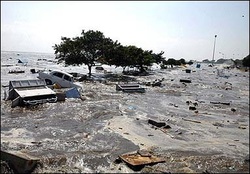Is the Maldives Sustainable or Not?
In short tourism in the Maldives is not sustainable at the rate it is
occurring. To be sustainable the industry must be in sync with the environmental,
social and economic factors concerning it and at the moment the Maldives
tourism industry is not. It may appear that the industry is sustainable from
the things they already appear to be doing however that is only on the surface
and authorities are ignoring the major unsustainable problems underneath.
Environmental:
The Maldives tourist industry is not sustainable for many reasons and the environment is being used in such a way that it cannot recuperate and replenish itself. The rubbish island Thilafushi is a good example of this as it is a major environmental and also health and safety risk that is not being addressed, only allowed to worsen. The tourism industry is harming the marine ecology and also the entire structure of the atolls themselves and if the Maldivian government is not careful, they will find that they have no basis for tourism anymore because they over used the resources and ruined them.
At the moment the economy in the Republic of Maldives appears to be great because the $600 million that the tourism industry is bringing in. However because the resorts are so susceptible the elements and total damage the entire economy can be wiped out in a matter of minutes so the country’s economy is also very susceptible to catastrophe. With more and more resorts and other tourist facilities being built the country also faces the risk of significant dept and other economic failure if they are not able to fill the beds up with tourists. The economy is also not sustainable because of the economic leakage that is occurring and with more resorts being built it means more of the money is going overseas and not to the Maldivians.
Many resorts are built out from the atolls on jetties as this provides tourists with a unique experience as it feels like you alone in the lagoon. However these resort rooms are very vulnerable to the elements and can be destroyed very quickly by the wind, waves and salt. If this happens it will put a lot of strain on the environment as the waste will be in the ocean which is already under strain and is vulnerable. Examples of this are the flooding and tsunami after the 2004 Indian Ocean earthquake. Six islands were destroyed, fourteen islands had to be evacuated and only nine islands escaped the flooding. This also had a serious effect on the economy as more than US$400, or 62% of the GDP was needed for damage.
Environmental:
The Maldives tourist industry is not sustainable for many reasons and the environment is being used in such a way that it cannot recuperate and replenish itself. The rubbish island Thilafushi is a good example of this as it is a major environmental and also health and safety risk that is not being addressed, only allowed to worsen. The tourism industry is harming the marine ecology and also the entire structure of the atolls themselves and if the Maldivian government is not careful, they will find that they have no basis for tourism anymore because they over used the resources and ruined them.
At the moment the economy in the Republic of Maldives appears to be great because the $600 million that the tourism industry is bringing in. However because the resorts are so susceptible the elements and total damage the entire economy can be wiped out in a matter of minutes so the country’s economy is also very susceptible to catastrophe. With more and more resorts and other tourist facilities being built the country also faces the risk of significant dept and other economic failure if they are not able to fill the beds up with tourists. The economy is also not sustainable because of the economic leakage that is occurring and with more resorts being built it means more of the money is going overseas and not to the Maldivians.
Many resorts are built out from the atolls on jetties as this provides tourists with a unique experience as it feels like you alone in the lagoon. However these resort rooms are very vulnerable to the elements and can be destroyed very quickly by the wind, waves and salt. If this happens it will put a lot of strain on the environment as the waste will be in the ocean which is already under strain and is vulnerable. Examples of this are the flooding and tsunami after the 2004 Indian Ocean earthquake. Six islands were destroyed, fourteen islands had to be evacuated and only nine islands escaped the flooding. This also had a serious effect on the economy as more than US$400, or 62% of the GDP was needed for damage.

